Introduction
In today's digitally-driven world, social media has become the epicenter of conversations, trends, and influential voices. But what if we told you that the key to understanding customer sentiment and unlocking the potential of influencer marketing lies within the realm of social media analytics? Welcome to a world where data-driven insights and powerful algorithms paint a vivid picture of consumer preferences and shape the future of marketing strategies. In this article, we invite you to embark on an enlightening journey to unravel the power of social media analytics, captivating your attention with compelling language, engaging visuals, and credible evidence. Join us as we decode the digital landscape, revealing how social media analytics can revolutionize the way we understand customer sentiment and leverage influencer marketing.
The Hidden Secrets of Social Media: Unveiling the Power of Analytics to Influence Consumer Sentiment
Prepare to have your mind blown as we dive deep into the labyrinth of social media, uncovering the untapped potential that lies within. Brace yourself for an exhilarating adventure as we unveil the hidden secrets of social media analytics, empowering businesses and marketers with the ability to decipher consumer sentiment and harness the influence of digital tastemakers. Join us on this groundbreaking journey as we explore the transformative impact of social media analytics, immersing ourselves in a world where data reigns supreme and consumer behavior becomes an open book.
The Rise of Social Media: A Window into Consumer Sentiment
a. The Social Media Revolution: Social media platforms have transformed the way we communicate, connect, and consume information. With billions of active users, these platforms serve as a treasure trove of valuable data and insights into consumer behavior.
b. The Importance of Customer Sentiment: Understanding customer sentiment is crucial for businesses to tailor their products, services, and marketing strategies to meet customer expectations. Social media provides an unprecedented opportunity to gauge sentiment at scale.
Unleashing the Power of Social Media Analytics: From Data to Insights
a. Mining the Data: Social media analytics harnesses advanced algorithms and machine learning techniques to extract valuable insights from the vast amount of data generated on social media platforms. This includes analyzing text, images, engagement metrics, and user demographics.
b. Sentiment Analysis: Sentiment analysis, a key component of social media analytics, allows businesses to identify and categorize sentiment expressed by users. By analyzing customer opinions, emotions, and attitudes, businesses can gain a deeper understanding of their target audience.
Influencer Marketing: The Era of Digital Tastemakers
a. The Rise of Influencers: Influencers have become the driving force behind consumer decisions and brand preferences. They possess the power to shape trends, sway opinions, and drive purchasing behavior through their authenticity and relatability.
b. Leveraging Influencer Insights: Social media analytics enables businesses to identify relevant influencers within their target market and analyze their impact. By understanding the reach, engagement, and sentiment associated with influencer content, marketers can optimize their influencer marketing strategies.
Real-Time Engagement: Proactive Customer Interaction
a. Monitoring Brand Mentions: Social media analytics allows businesses to monitor brand mentions in real-time, enabling them to respond promptly to customer feedback, inquiries, and complaints. This fosters proactive customer engagement and enhances brand reputation.
b. Crisis Management: Social media analytics provides a valuable tool for crisis management. By monitoring sentiment during crises, businesses can take swift action, mitigate negative sentiment, and preserve brand image.
Data-Driven Decision Making: From Insights to Action
a. Tailoring Marketing Strategies: Social media analytics empowers businesses to refine their marketing strategies based on consumer sentiment, preferences, and behavior. By aligning their messaging and offerings with customer expectations, businesses can enhance their competitive edge.
b. Measuring Campaign Effectiveness: Social media analytics enables businesses to measure the impact of their marketing campaigns in real-time. Through key performance indicators (KPIs) such as engagement rates, conversions, and sentiment analysis, businesses can optimize their campaigns for maximum results.
Conclusion
In the digital age, social media analytics has emerged as a powerful tool to unlock the secrets of customer sentiment and leverage the influence of digital tastemakers. By harnessing the wealth of data available on social media platforms, businesses can gain invaluable insights into consumer behavior, tailor their marketing strategies, and drive meaningful engagement. Social media analytics is the key to decoding the digital landscape, transforming the way businesses understand and connect with their target audience. Embrace the power of social media analytics, and embark on a journey where data-driven insights lead to unrivaled success in the ever-evolving world of digital marketing.

Comments
Post a Comment